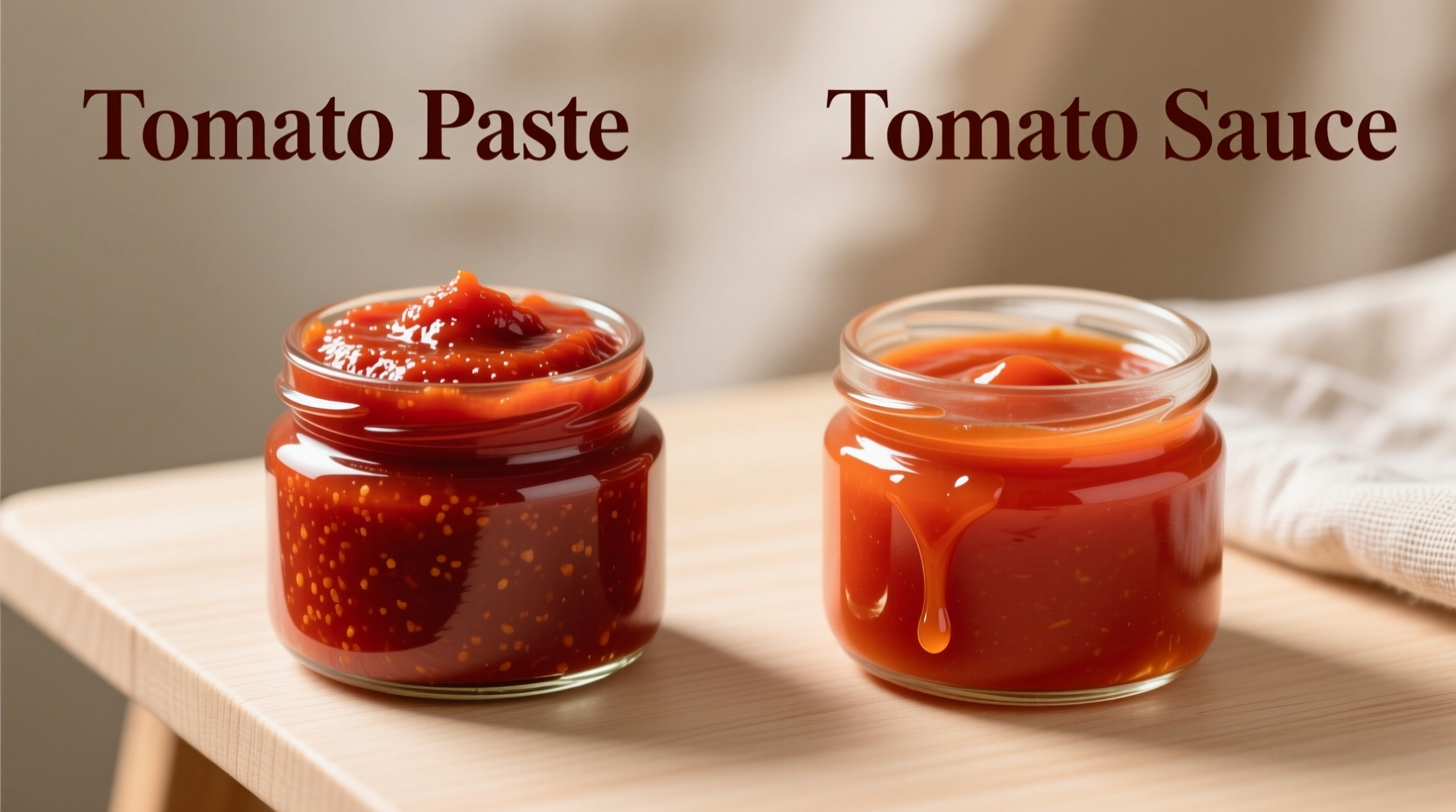Tomato paste is a thick, concentrated product made from cooked-down tomatoes with most water removed, while tomato sauce is a thinner, ready-to-use liquid with added seasonings. Use paste for intense tomato flavor and thickening power, and sauce for immediate liquid base in dishes.
Understanding the difference between tomato paste and tomato sauce isn't just culinary trivia—it directly impacts your cooking results. Many home chefs mistakenly use these products interchangeably, leading to watery sauces or overly intense flavors. The key distinction lies in concentration: tomato paste contains about 24-30% tomato solids, while tomato sauce typically has only 8-12%. This fundamental difference affects texture, flavor intensity, cooking time requirements, and proper usage in recipes.
What Exactly Sets Them Apart?
Tomato paste undergoes extensive reduction, cooking tomatoes down to remove nearly all water content. This creates a rich, intensely flavored product that serves as a flavor foundation. Tomato sauce, by contrast, is a thinner preparation with added ingredients like onions, garlic, and herbs, designed as a ready-to-use component.
| Characteristic | Tomato Paste | Tomato Sauce |
|---|---|---|
| Tomato Solids | 24-30% | 8-12% |
| Water Content | ~70% removed | Nearly full |
| Texture | Thick, almost paste-like | Pourable liquid |
| Flavor Profile | Intense, concentrated tomato | Milder, with added seasonings |
| Typical Use | Flavor base, thickening agent | Ready-to-use component |
| Preparation Time Needed | Requires cooking to mellow | Ready to incorporate |
The Production Process: Why Concentration Matters
According to the Food and Agriculture Organization's guidelines on tomato processing, tomato paste undergoes multiple cooking stages to reduce water content while developing complex flavors through caramelization. The tomatoes are first cooked to remove about 80% of their water, then passed through fine screens to remove seeds and skins, and finally cooked again to reach the proper concentration.
Tomato sauce follows a different path—it's cooked only enough to blend flavors while maintaining a liquid consistency. The USDA's Food Processing Technology documentation confirms that commercial tomato sauce typically contains added ingredients like salt, citric acid, and natural flavors that aren't present in pure tomato paste.

When to Use Each: Practical Cooking Guidance
Your choice between tomato paste vs tomato sauce should depend on what your recipe needs:
Reach for Tomato Paste When:
- You need to build deep tomato flavor in sauces, stews, or braises
- Thickening a liquid without adding additional ingredients
- Creating a flavor foundation (always cook paste for 2-3 minutes before adding liquids)
- Boosting umami in vegetarian dishes as a meat substitute
Choose Tomato Sauce When:
- You need a ready-to-use base for quick pasta sauces
- Adding liquid volume to dishes without extended cooking time
- Preparing weeknight meals where speed matters
- Following recipes specifically calling for "tomato sauce"
Substitution Guide: Making the Switch
While not perfect substitutes, you can adapt when you have only one product available:
Using Tomato Sauce Instead of Paste:
To replace 1 tablespoon of tomato paste, use 3 tablespoons of tomato sauce and simmer until reduced by two-thirds. This concentrates the flavor and removes excess liquid. The National Center for Home Food Preservation notes that proper reduction prevents watery final products.
Using Paste Instead of Sauce:
Mix 1 part tomato paste with 2 parts water, plus 1/4 teaspoon sugar and a pinch of salt to approximate tomato sauce. For better results, add sautéed garlic and herbs. Remember that commercial tomato sauce contains additional seasonings that plain paste won't replicate.
Nutritional Comparison
According to USDA FoodData Central, both products share similar base nutrition but differ in concentration:
- Tomato paste (2 tbsp): 30 calories, 7g carbs, 1.4g fiber, 22,000 IU vitamin A (440% DV), rich in lycopene
- Tomato sauce (1/2 cup): 45 calories, 11g carbs, 2g fiber, 16,000 IU vitamin A (320% DV)
The higher concentration in paste means you use less, potentially reducing overall calorie intake while increasing lycopene absorption—especially when cooked with healthy fats.
Proper Storage Techniques
The FDA's Food Code provides clear guidance on storing both products:
- Unopened cans: Store in cool, dry place for 12-18 months
- Opened tomato paste: Transfer to airtight container, cover surface with olive oil, refrigerate for up to 10 days or freeze in portions for 6 months
- Opened tomato sauce: Refrigerate in original container with tight lid for 5-7 days
For frequent users, freezing tomato paste in ice cube trays then transferring to freezer bags provides ready-to-use portions that prevent waste.
Common Mistakes to Avoid
Professional chefs consistently identify these errors when working with tomato products:
- Adding tomato paste directly to liquids without cooking it first (creates metallic flavor)
- Using tomato sauce in place of paste without reducing excess liquid
- Storing opened tomato paste in the original can (causes metallic taste)
- Assuming all "tomato products" are interchangeable across cuisines
Remember that regional cooking traditions treat these products differently. Italian chefs often use tomato paste as a flavor foundation in soffritto, while Mexican cooks might incorporate tomato sauce directly into simmering dishes.











 浙公网安备
33010002000092号
浙公网安备
33010002000092号 浙B2-20120091-4
浙B2-20120091-4